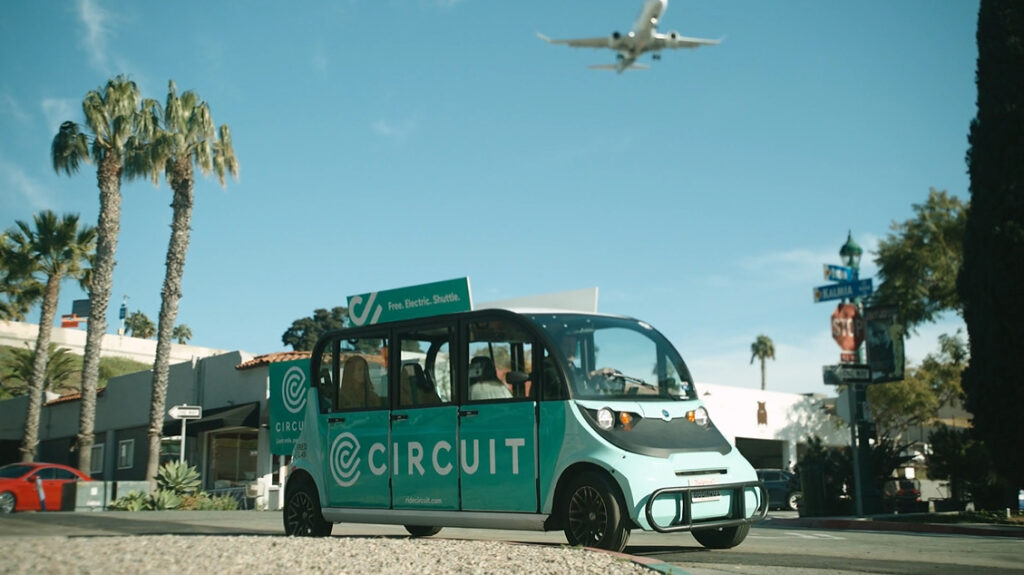
A free, door-to-door electric shuttle pilot program is projected to launch in June after the Coronado City Council gave final approval to a contract with the shuttle provider at its March 19 meeting.
The shuttle will provide on-demand rides within Coronado, including the Cays, for six months. Riders can request a shuttle on an app or by making a phone call. It will run from 10 a.m. to 9 p.m. Monday through Thursday and 9 a.m. to 10 p.m. on Friday and Saturday.
Mayor Richard Bailey opposed the program, saying it was too expensive and that he thought it would not achieve its policy goal of reducing carbon dioxide emissions and the number of cars on the road. He referenced Coronado’s free summer shuttle, whose future the council is debating, and questioned whether this was another similar inefficient program.
But the rest of the council thought the shuttle could solve problems with the summer shuttle by providing on-demand, door-to-door service as opposed to a fixed route. The theory is that potential riders who live far from Orange Ave., where the summer shuttle runs, are less likely to ride, but they may utilize a door-to-door option.
The pilot will cost approximately $600,000, and once it concludes, the council will assess whether to make it a permanent program. If it does, the shuttle likely would no longer be free.
“We need to get as much data as we can,” said City Councilmember Mike Donovan. “We aren’t smart enough now to make an informed decision.”
By running a free pilot, the city hopes it will discern demand for the shuttle and potentially tailor a long-term shuttle around it. Aside from Bailey, council members agreed that making the shuttle as accessible as possible during the pilot months would help gather requisite information.
The city will operate six GEM electric vehicles and two electric passenger vans to service the Cays (one of which is wheelchair accessible), plus a standby ADA-compliant vehicle for passengers who need additional accommodations.
Once the pilot program concludes, the council may adjust operating hours, number of vehicles, and, as mentioned, ride cost, to decrease the cost of the shuttle.
The program was originally slated to launch in March, but was delayed as the city finalized its contract with Circuit, the company who will operate the shuttle. City staff asked for direction from council from four sticking points in the contract at the March 29 meeting.
First, Circuit had not yet determined where it would store and charge its vehicles overnight. The company said it was in negotiations with the Coronado Island Marriott Resort and Spa to store its vehicle there, and that Circuit would install charging stations on the hotel property.
Another issue was where the vehicles would park while waiting for riders. Circuit preferred to park near businesses to better advertise the service, but the council didn’t want to contribute to already sparse parking in areas such as Orange Ave. The council considered saying only one vehicle could park in congested areas, but ultimately approved the contract as written, which stipulates that shuttles cannot park in one public spot for more than 15 minutes.
The city also opted to cover the cost of a call center for about $13,000 for the six-month pilot so that passengers who are resistant to using an app can request a ride by phone.
Finally, the city and Circuit hit a snag in negotiations of payment. The city wanted to include language stating that the estimated $600,000 cost of the contract would be adjustable if the city decreased its operating hours or number of vehicles operating during the contract. Circuit indicated that it had no issue with this conceptually, but wanted to specify what circumstances would render the payment “adjustable.”
Although expensive, most of the council (Bailey excepted) were hopeful that this could be a viable way for the city to meet its carbon reduction goals and decrease congestion in the city.
“I don’t like the price tag, but there isn’t a great price tag for anything,” said Councilmember Casey Tanaka. “This program is a pilot program because we want to see if the ridership numbers match our expectation that our residents would want this type of service, especially at the magic cost of free.”
RELATED




